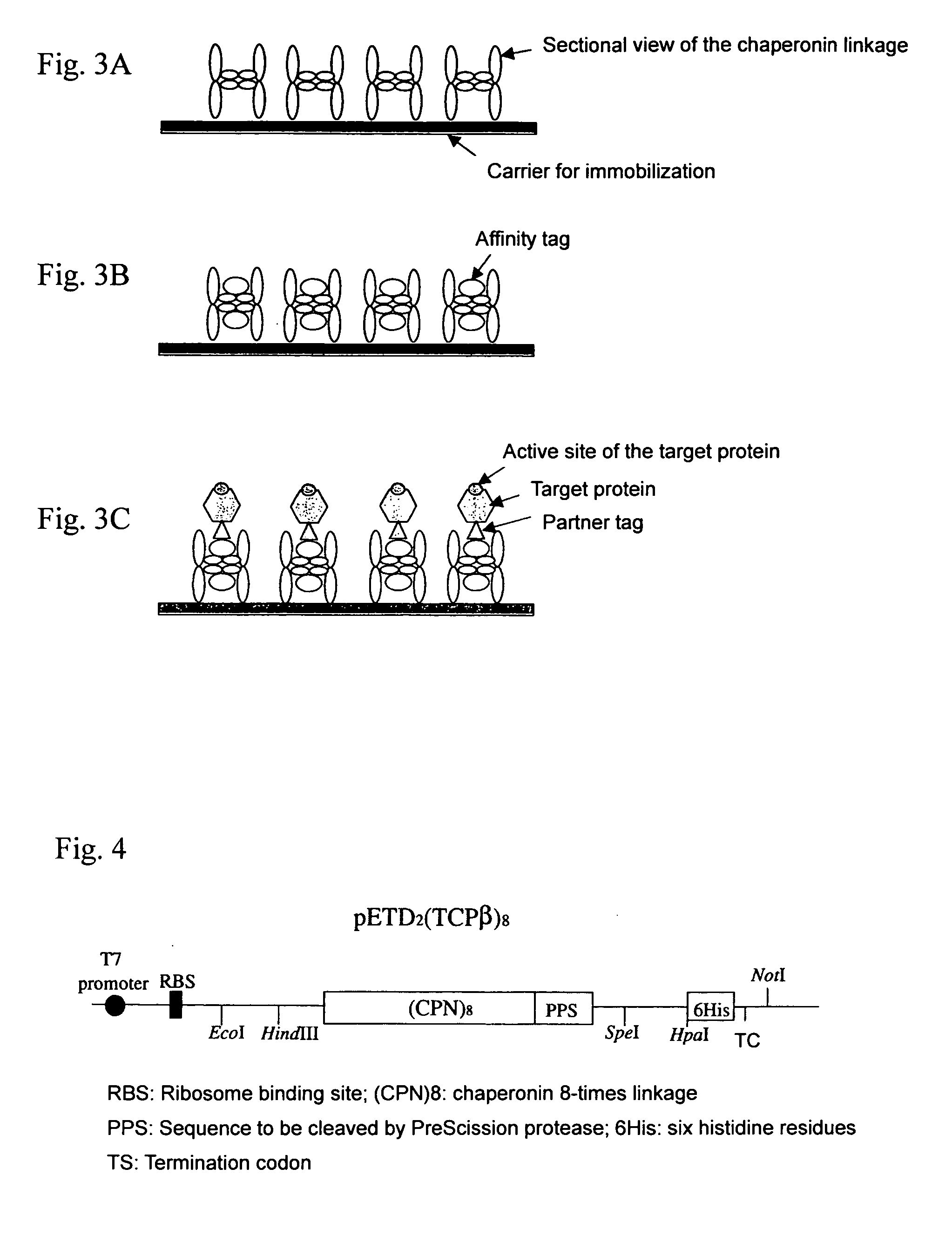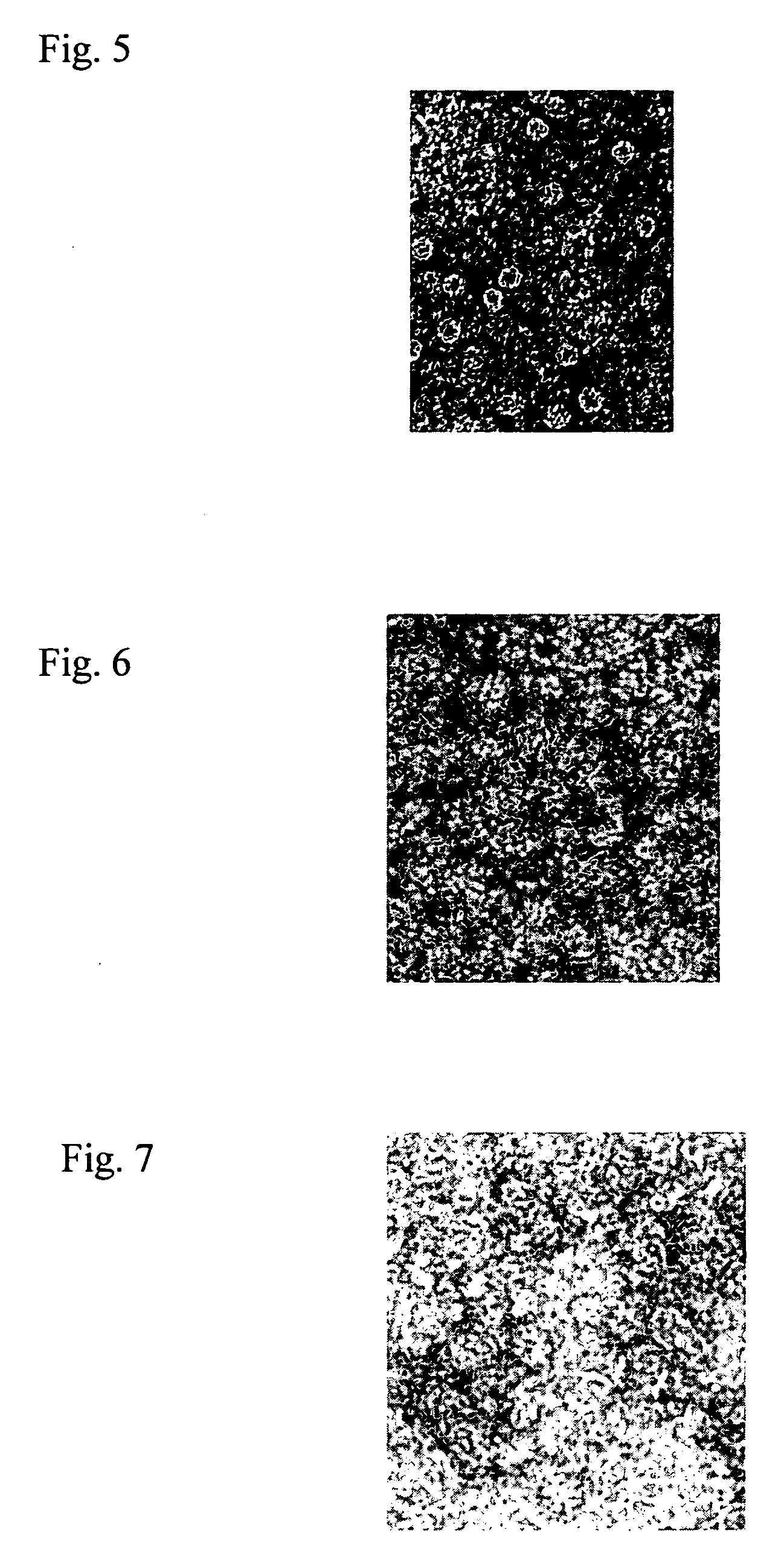Chaperonin-target protein complex, method of producing the same, method of stabilizing target protein, method of immobilizing target protein, method of analyzing the structure of target protein, sustained-release formulation, and method of producing antibody against target protein
a target protein and protein technology, applied in the field of chaperonintarget protein complex, can solve the problems of preventing the activity of the immune system from functioning properly, the higher-order structure of the protein, and the inability to translate the gene well with the protein expression, so as to achieve the effect of carrying out the immune response more efficiently
- Summary
- Abstract
- Description
- Claims
- Application Information
AI Technical Summary
Benefits of technology
Problems solved by technology
Method used
Image
Examples
example 1
(Construction of an expression vector for Thermococcus strain KS-1 chaperonin β subunit linkage)
[0095] In order to prepare a double-stranded DNA, a linker F1 as shown in SEQ ID No. 9 and a linker RI as shown in SEQ ID No. 10 that are complementary nucleotide sequences were annealed. The double-stranded DNA includes an NcoI site, an XhoI site, a nucleotide sequence that is translated to be converted to a PreScission protease site, an Spel site, an HpaI site, a nucleotide sequence that is translated to be converted to a histidine tag, and a termination codon. The double-stranded DNA was treated with NcoI / XhoI, and ligated to pET21d (Novagen) treated in advance with the restriction enzymes. A plasmid obtained thereby was designated pETD2.
[0096] Meanwhile, a chaperonin β subunit (TCPβ) gene as shown in SEQ ID No. 1 was cloned by PCR (Polymerase chain reaction) using genomic DNA of Thermococcus strain KS-1 as a template. The genomic DNA of Thermococcus strain KS-1 was prepared by a ph...
example 2
(Construction of an expression system for a fusion protein composed of a chaperonin β subunit 8-times linkage and protein A)
[0098] On the other hand, in order to clone a protein A gene as an affinity tag, the protein A gene as shown in SEQ ID No. 2 was cloned by PCR using genomic DNA of Staphylococcus aureus as a template. The genomic DNA of Staphylococcus aureus was prepared in a manner similar to Example 1 using pellets recovered from suspension of strains (DSM 20231) obtained from DSM in Germany. Pro-F1 primer as shown in SEQ ID No. 13 and pro-R1 primer as shown in SEQ ID No. 14 were used as a primer set for PCR. Herein, a Spel site and an HpaI site were provided respectively at the pro-F1 primer and the pro-R1 primer. As well as Example 1, an amplified DNA was introduced into pT7BlueT vector by TA cloning, with the result of confirmation of its nucleotide sequence being the same as a nucleotide sequence as shown in SEQ ID No. 2. Next, a DNA fragment containing a protein A gene...
example 3
(Expression and Purification of a chaperonin β subunit 8-times linkage-protein A fision protein)
[0099] The pETD2(TCPβ)8-ptnA was introduced into Escherichia coli strain BL21 (DE3) to give a transformant. In order to express a chaperonin subunit 8-times linkage (TCPβ)8, the transformant was cultured at 35° C. in 2xYT medium (Bacto-trypton 16 g, Yeast extract 10 g, and NaCl 5 g / L) containing carbenichillin (100 μm / mL), whereupon IPTG was added so as to get a final concentration of 1 mM at the point when OD600 reached 0.7. After the transformant was cultured for about 16 hours further, the cells were harvested and disrupted by sonication to recover supernatant with centrifugation.
[0100] The supernatant was subjected to a nickel chelating column equilibrated in advance with A solution (25 mM Tris-HC1 / 0.5 M NaCl / 1 mM imidazole (pH 7.0)), whereupon a chaperonin β subunit 8-times linkage-protein A fusion protein was eluted by a linear gradient using B solution (25 mM Tris-HC1 / 0.5 M NaCl...
PUM
| Property | Measurement | Unit |
|---|---|---|
| Structure | aaaaa | aaaaa |
| Molecular weight | aaaaa | aaaaa |
| Affinity | aaaaa | aaaaa |
Abstract
Description
Claims
Application Information
 Login to View More
Login to View More - R&D
- Intellectual Property
- Life Sciences
- Materials
- Tech Scout
- Unparalleled Data Quality
- Higher Quality Content
- 60% Fewer Hallucinations
Browse by: Latest US Patents, China's latest patents, Technical Efficacy Thesaurus, Application Domain, Technology Topic, Popular Technical Reports.
© 2025 PatSnap. All rights reserved.Legal|Privacy policy|Modern Slavery Act Transparency Statement|Sitemap|About US| Contact US: help@patsnap.com



